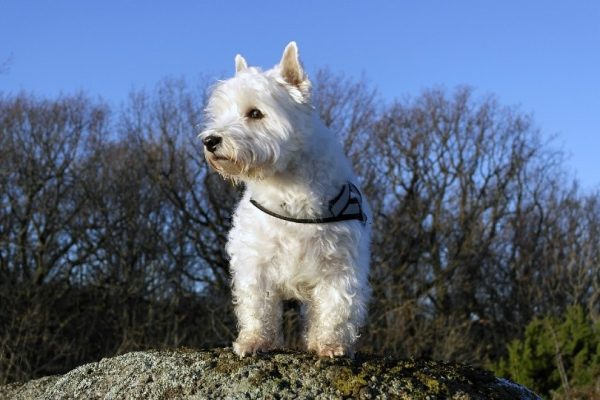We understand wanting to travel or at least cruise around with your canine companion. After all, they are probably by your side doing many other activities, so it only makes sense you’d want to take them on your motorcycle. While dogs may handle car rides all right, putting them in or on a bike is a different story. There’s a lot for your pup to tolerate, and that’s saying nothing about the noise, as the decibel levels of motorcycles can reach 100 dB or more. Not all dogs will be able to cope well or learn to enjoy this type of activity, and should not be forced into it.
We want to start by saying that although we don’t recommend taking your pet on your motorcycle, that doesn’t mean that your dog won’t cope well with accompanying you on bike rides. Plus, some dogs are simply adventurous and enjoy feeling the wind in their fur. However, if you plan on doing this, know that there are definitely some safety precautions you need to take.

The 8 Tips for Taking Your Dog on a Motorcycle
1. Speak to Your Vet
Before even thinking about getting your dog to join you on motorcycle rides, it’s important to speak to your veterinarian. Not every dog is suitable for this type of activity, and this will greatly depend on their breed, size, age, health, temperament, and other factors. Older dogs, puppies, dogs suffering with underlying health issues such as heart disease, arthritis, diabetes, mobility issues, and others, may not cope very well. Their health may be at risk if they join such an activity that may lead to fear, excitement, or stress. Older dogs and those suffering with painful joints, or recovering after an injury, may not be comfortable being in a certain standing or lying position in a carrier for a prolonged time. For puppies, this may also not be appropriate depending on their age, and they will need gradual training if they are to accept this type of activity.
Your vet can give you guidance, tips, and their honest advice if your dog will be suitable to join you on such adventures, but this will also depend on whether you are planning to take them on short trips within a few blocks, such as taking them to the vet, or if you are planning a road trip that may take hours, or even days.
If you need to speak with a vet but can't get to one, head over to PangoVet. It's our online service where you can talk to a vet online and get the advice you need for your dog — all at an affordable price!
2. Check the Legality in Your State
You should check the legal side of things before you start buying stuff to outfit your dog for the road. Some states or areas may prohibit dogs on bikes, while others may have specific regulations about how you can transport your pet. Remember that these laws strive to protect the animal and the general public. Safety is the paramount concern, so be sure to do your homework!

3. Take into Account Your Pup’s Weight and Size When Choosing a Carrier
Consider the weight and size of your dog when choosing the best way to transport your pet. Research the available options to determine if they’ll work with your ride. You may find a sidecar is the best way to manage the extra stuff you must pack for day trips. Ensure that whatever carrier you use complies with state and local regulations to avoid any unnecessary hassle, while ensuring the top safety of your pooch.
Remember that your pup and their gear will add to the total weight and can affect your maneuverability on the road. Also, let your dog explore their carrier before putting it on your bike. It’ll make it seem less scary when it’s time for the real thing.
4. Make Sure You Have Plenty of Room for Supplies
You must pack for your dog whether on a day trip or an extensive tour. That means the usual supplies for traveling, including bowls, food, treats, waste bags, and other items. This should all be accessible for short rest stops on your trek. There’s nothing worse than having to unpack just to get to a water bowl that should have been on top of everything.

5. Pack for Safety With a Helmet and Dog Goggles
Yes, doggie helmets and goggles exist, although probably not at your local pet store. They fall into the specialty realm because of the limited market. Ensure you’re getting products that are designed for this purpose to make sure they’re safe and will protect your pup. Many are made to order, requiring accurate measurements for a good fit. Some include goggles with UV protection to keep your pet covered, as well as hearing protection in helmets to save their sensitive ears from the loud rumble of the engine.
Many dogs may not tolerate wearing helmets or goggles at first, and they may need gradual training to accept wearing them. None of the gear should be uncomfortable or tight, as it may cause your dog discomfort or even injuries after prolonged time of being worn. It goes without saying that your bike speed should be much slower when your pooch accompanies you on a ride, and there should be frequent breaks for both short toilet walks and an opportunity for your dog to stretch their legs properly during a normal walk and playtime.
6. Dress Your Dog for the Weather
You’ll also find clothing to deck out your pooch, whatever the weather. You’ll see cooling vests for days when the temperature soars and heavy coats and jackets for windy rides on chilly fall trips. We recommend getting a harness for your pet to keep them secure to your tank or the carrier you’ve attached to your bike. Always check the weather before you take to the road with your pooch. Avoid driving at all if it’s too hot or cold, as it may lead to heatstroke, sunburns in the summer, or frostbites and hypothermia in the winter.

7. Get Your Dog Used to Riding and Wearing Their Gear With Short Trips
Getting your dog used to wearing their gear is imperative. It’s a critical part of making your rides safer. That same caution applies to being on the bike. There’s a lot for a pooch to tolerate the first time out on the road. Treats will make the process quicker with a potent motivator to stick it out and enjoy being in the breeze. Start with very short, slow trips on less busy roads before graduating to more busy areas. Always ensure the safety of your dog, by keeping them securely attached with a harness and a lead to the carrier or the bike itself, and observe their body language. If they are scared or stressed, stop the ride and do not force them into an activity they dislike or that makes them uncomfortable. It won’t bring either of you any joy or pleasure.
8. Travel With Something That Smells Like Home
Bringing something that smells like home is an excellent stress reliever for your dog, whether or not you travel by motorcycle. You can also put your pup’s favorite blanket in their carrier or the sidecar to keep familiar scents around them and calm your pet. It can keep your pooch warm from the wind and help them better manage the bumps.


Final Thoughts
Taking your dog on the road with you may be a way to bond with your canine companion. It can introduce novel experiences and bring them to new places for mental stimulation and enrichment. Of course, not every pup is born to ride shotgun. However, if you take things on your pet’s time, you’ll find they are more likely to become your riding buddy.
Featured Image Credit: William Hager, Shutterstock


















